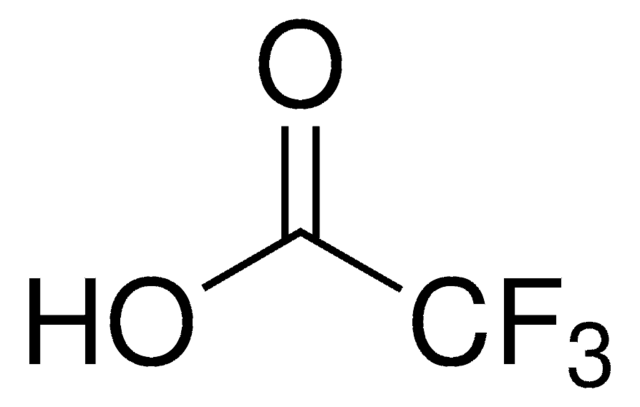1.08262
Acide trifluoroacétique
for spectroscopy Uvasol®
Synonyme(s) :
TFA
About This Item
Produits recommandés
Densité de vapeur
3.9 (vs air)
Niveau de qualité
Pression de vapeur
97.5 mmHg ( 20 °C)
Pureté
≥99.8% (acidimetric)
Forme
liquid
Technique(s)
UV/Vis spectroscopy: suitable
Impuretés
≤10% Water (Karl Fischer)
Résidus d'évap.
≤0.005%
Couleur
APHA: ≤10
Transmittance
265 nm, ≥10.0%
305 nm, ≥50.0%
320 nm, ≥80.0%
325 nm, ≥90.0%
Indice de réfraction
n20/D 1.3 (lit.)
pH
1 (10 g/L in H2O)
Point d'ébullition
72.4 °C (lit.)
Pf
−15.4 °C (lit.)
Solubilité
soluble 10 g/mL
Densité
1.489 g/mL at 20 °C (lit.)
Température de stockage
2-30°C
Chaîne SMILES
OC(C(F)(F)F)=O
InChI
1S/C2HF3O2/c3-2(4,5)1(6)7/h(H,6,7)
Clé InChI
DTQVDTLACAAQTR-UHFFFAOYSA-N
Vous recherchez des produits similaires ? Visite Guide de comparaison des produits
Description générale
Application
- Characterization of ribostamycin and its impurities using a nano-quantity analyte detector: This study examines ribostamycin and its impurities using a nano-quantity analyte detector and details a systematic comparison of three different aerosol detectors. The role of trifluoroacetic acid as a mobile phase additive enhances detection sensitivity and analytical precision, making it crucial for accurate impurity profiling and pharmaceutical quality control (Meng et al., 2024).
- Paradigm Shift: Major Role of Ion-Pairing-Dependent Size Exclusion Effects in Bottom-Up Proteomics Reversed-Phase Peptide Separations: This research highlights the critical role of trifluoroacetic acid in modifying the ion-pairing and size exclusion properties of peptides during reversed-phase separations in proteomics. The study provides a deeper understanding of the mechanisms influencing peptide behavior, which is essential for developing more effective analytical techniques (Yeung et al., 2024).
- New fabric phase sorptive extraction for nondestructive analysis of heritage textile samples: This paper introduces a novel fabric phase sorptive extraction method using trifluoroacetic acid among other solvents to analyze heritage textile samples nondestructively. This method demonstrates significant potential in cultural heritage preservation and forensic science by allowing detailed analysis without damaging the original artifacts (Tanasescu et al., 2024).
- Preparation and characterization of stationary phase gradients on C8 liquid chromatography columns: The study discusses the preparation and characterization of stationary phase gradients for chromatography columns, with trifluoroacetic acid used to adjust the pH and ionic strength of the mobile phase. This modification is shown to enhance the chromatographic separation of complex mixtures, proving vital for analytical and preparative scale separations (Cecil et al., 2024).
- Optimization of Cyanocobalamin (Vitamin B(12)) Sorption onto Mesoporous Superparamagnetic Iron Oxide Nanoparticles: This investigation utilizes trifluoroacetic acid in the synthesis and functionalization of nanoparticles for efficient vitamin B(12) sorption. The study explores the implications for targeted drug delivery systems and bioseparation, demonstrating the adaptability and effectiveness of these engineered nanoparticles (Flieger et al., 2024).
Remarque sur l'analyse
Eau (K. F.) : ≤ 0,10 %
Numéro de couleur (alpha) : ≤ 10
Résidu d′évaporation : ≤ 0,005 %
Transmission UV (à 265 nm) : ≥ 10,0 %
Transmission UV (à 305 nm) : ≥ 50,0 %
Transmission UV (à 320 nm) : ≥ 80,0 %
Transmission UV (à partir de 325 nm) : ≥ 90,0 %
Autres remarques
Informations légales
Produit(s) apparenté(s)
Mention d'avertissement
Danger
Mentions de danger
Classification des risques
Acute Tox. 4 Inhalation - Aquatic Chronic 3 - Eye Dam. 1 - Skin Corr. 1A
Code de la classe de stockage
8A - Combustible, corrosive hazardous materials
Classe de danger pour l'eau (WGK)
WGK 2
Point d'éclair (°F)
212.0 °F - Pensky-Martens closed cup
Point d'éclair (°C)
> 100 °C - Pensky-Martens closed cup
Certificats d'analyse (COA)
Recherchez un Certificats d'analyse (COA) en saisissant le numéro de lot du produit. Les numéros de lot figurent sur l'étiquette du produit après les mots "Lot" ou "Batch".
Déjà en possession de ce produit ?
Retrouvez la documentation relative aux produits que vous avez récemment achetés dans la Bibliothèque de documents.
Les clients ont également consulté
Articles
Being one of the most popular flavors, we present a HPLC fingerprint method and vanilla extract reference materials to help distinguish natural from synthetic or adulterated vanilla.
Protocoles
Straightforward HPTLC-MS analysis of lactose in dairy products (milk or yoghurt) using only protein crash, centrifugation and dilution as sample preparation.
Aripiprazole is an atypical antipsychotic and a partial dopamine agonist. It is primarily used in the treatment of schizophrenia, bipolar disorder, major depressive disorder, tic disorders, and irritability associated with autism. Aripiprazole was first approved by the U.S. Food and DrugAdministration in November 2002 for schizophrenia and by the European Medicines Agency in June 2004 for acute manic and mixed episodes associated with bipolar disorder.
Catalyst screening, KitAlysis™ High-Throughput Screening Kits, Thin layer chromatography (TLC), parallel analysis, parallel synthesisigh-Throughput Buchwald-Hartwig Amination Reaction Screening Kit, TLC-MS analysis
Notre équipe de scientifiques dispose d'une expérience dans tous les secteurs de la recherche, notamment en sciences de la vie, science des matériaux, synthèse chimique, chromatographie, analyse et dans de nombreux autres domaines..
Contacter notre Service technique





